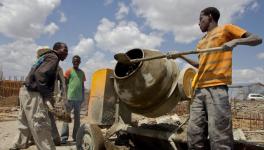India’s Anti-Satellite Missile: Beyond the Euphoria

Image Courtesy: Live Mint
Now that the excitement and self-congratulatory chest-thumping over India’s successful testing of its anti-satellite missile (ASAT) capability on March 27, 2019 has passed, except of course for continuous misuse in political campaigns by Prime Minister Narendra Modi, it is time to take a step back and look at the event and its strategic implications with a clearer head and a broader perspective.
As will be seen, the boast by Modi in his telecast that the test was a moment of “utmost pride”, would have impact “for generations to come,” and meant that India was “now a space power,” with another Minister Nitin Gadkari adding that India was now “not only an economic superpower but also a science superpower,” are gross exaggerations.
Additionally, the aggressive and militaristic tone of the Prime Minister himself, both in his broadcast phraseology of “satellite ko maar giraya” (killed and brought down the satellite) and his subsequent election campaign speeches, as well as the irrepressible BJP leader Subramanian Swamy claiming that now Pakistan’s fighter aircraft would be blinded, do not sit well with the PM’s broadcast statement that India remained opposed to the weaponisation of space.
While India does indeed now become the fourth country after the US, Russia and China, to possess proven ASAT capability, although France and Israel too are believed to have such capability even if not formally declared or demonstrated, its utility as a strategic game-changer is much in doubt.
Far from providing definitive strategic positives for India, its ASAT test in fact poses important questions for India’s strategic outlook and related future technology options. It also poses significant policy challenges for India in respect of international arms control regimes, especially with regard to militarisation of space as against its peaceful and cooperative use for the benefit of humankind.
Indian Capability and Weapon Demonstration
It should be noted that the idea of ASAT weaponry has a hoary history going almost as far back as the first satellites in space, which immediately triggered the perceived threat of military uses by both the US and the then Soviet Union. The Soviets are believed to have achieved the world's first ASAT kill in 1968 when it used another satellite to fire steel pellets to cripple a Soviet orbiter, but later switched to using a ground-based missile for the purpose.
In 1985, the US used an F-15 fighter aircraft to fire a missile and destroy an old American satellite orbiting at around 555 km altitude. In 2008, it destroyed a malfunctioning spy satellite using a ship-fired RIM-161 SM3 missile, part of the Aegis ballistic missile defence (BMD) system against medium- and long-range ballistic missiles. Both the US and the Soviet Union developed their ASAT capabilities starting from their BMD programmes, and their ASAT missiles have essentially been land-based systems.
China conducted its ASAT test in 2007 using a surface-to-air missile to destroy a defunct weather satellite, at an altitude of around 865km. China was initially reluctant to admit to conducting the test but was soon compelled to publicly acknowledge it, mostly because of the resultant huge debris cloud of over 3,000 pieces, about which more later.
India’s interest in BMD systems was aroused around 1999 by Pakistan’s growing missile capability and its acquisition of M-9 and M-11 missiles from China and No-dong missiles from North Korea. At that time, India based its ASAT programme around an extended high-altitude version of its Prithvi BMD interceptor, which was tested successfully several times in the Bay of Bengal for interception of incoming medium-range and long-range ballistic missiles.
India initiated its ASAT programme a few months after China’s ASAT test but formally announced an ASAT programme only in 2010. In 2013, after the successful testing of the Agni-5 ICBM, then Director General, Defence Research and Development Organisation (DRDO) and former Scientific Advisor to the Defence Ministry, V.K.Saraswat, now a National Democratic Alliance political appointee as Member, NITI Aayog, declared that India now had “fantastic opportunities for ASAT capability,” and required only to develop matching seekers and guidance systems to go with the “kill vehicle.” Yet another example for PM Modi to claim exclusive credit for a strategic programme initiated many years ago under a different political dispensation!
Problem of Debris
All these ASAT missiles are “kinetic kill” vehicles, in other words, these destroy their targets by physically colliding with them, against other BMD systems that carry explosive warheads which destroy their targets through an explosion in close proximity. Nevertheless, ASAT attacks on satellites create substantial debris, clouds of which continue to orbit the earth posing serious threats to other orbiting satellites, including the majority of satellites dedicated exclusively to civilian uses. The higher the altitude of the satellite hit, the longer the debris would last in space, whereas debris in lower orbits would lose momentum sooner and burn out upon re-entering the atmosphere.
The problem of space debris has long been a problem faced by space-faring nations and users of their mostly civilian satellites all over the world. The problem has only worsened with time with the almost exponential growth of satellites, especially for communication, entertainment, developmental planning, resource exploration, mapping, tracking and location services etc.
Space debris has been a major factor inhibiting extensive testing of ASAT weapons. This perhaps largely explains why even the few nations that have developed ASAT weapons, have only conducted one or two physical tests. While there is no international treaty or other agreement governing space debris, there is an active Inter-Agency Space Debris Coordination Committee (IADC) functioning under the UN Committee on the Peaceful Uses of Outer Space, of which ISRO is a member on behalf of India, and which develops and issues guidelines and recommendations from time to time.
China’s 2007 test, for instance, caused considerable international uproar because of the over 2,000 large pieces of debris it generated. This debris is believed to have resulted in the destruction of or serious damage to at least one, some say two, Russian satellites. China’s test took place at an altitude of around 800 km and a substantial proportion is believed to be still in orbit around the earth and is likely to remain there much longer.
The IADC has, therefore, identified two priority regions in space that are most vulnerable to risks posed by space debris, namely the Low-Earth Orbit (LEO) or up to 2,000km above the earth, and the Geo-Stationary Orbit (GSO) or around 36,000km above the earth, where a satellite will appear to remain stationary above a particular point on earth, particularly useful for communications purposes, since tracking or receiving stations on the ground can remain pointed in the same direction at all times, such as satellite TV dishes.
In these two belts, IADC calls for avoidance of “intentional destruction of a space system and other harmful activities that may significantly increase collision risks,” and for “intentional break-ups [to] be conducted at sufficiently low altitudes so that orbital fragments are short-lived.”
India’s ASAT test was conducted at around 300km. The test itself was closely monitored by US agencies and surveillance systems, reportedly including airborne systems from its controversial Indian Ocean base in Diego Garcia, albeit denied by the US.
Indian space agencies and several international experts are of the opinion that, given the low altitude and the relatively small size of the target -- Microsat-R satellite -- the quantity of debris is limited and likely to degrade in the atmosphere in a few weeks. Yet, recent statements by National Aeronautics and Space Administration (NASA) have attacked the Indian test in strong language as causing “terrible, terrible” debris that could threaten the International Space Station (ISS) orbiting the earth at around 350km, with some debris from the Indian ASAT test apparently reaching that altitude.
However, to put the issue in perspective, there are believed to be around 34,000 pieces of debris in space larger than 10cm of which only around 80 are believed to be of Indian origin before the ASAT test. NASA is said to be currently tracking around 70 large pieces from the Indian ASAT test.
Utility of ASAT Missiles and Other Options
Besides the concern over space debris, there are other significant reasons why ASAT missiles may really not be a particularly good choice to take out or disable satellite surveillance or other inimical activities by adversaries. Indeed, this may explain why other ASAP-capable nations are not believed to have extensive stockpiles of ASAT missiles or active programmes to continue their development or upgradation. The utility of India embarking on an ASAT missile development programme at this juncture is, therefore, questionable.
Around 2,000 satellites are currently in orbit. Of these around 300 are believed to be purely military satellites, about half of them of the US, and the remaining Russian and Chinese. Countries such as the US, Russia, China and the European Union States use a variety of their own satellites for military purposes, such as terrestrial and maritime surveillance, intelligence gathering, communications, navigation, network systems, radar and other monitoring etc.
India has a much smaller military space programme, which is only now picking up pace but is way behind China’s, and is believed to have about 13 satellites serving military or dual-purpose applications. Many other countries in Asia and West Asia have a few solely military or dual-purpose satellites launched for them by third parties, and countless others use conventional commercial satellites for military or related purposes, or are allowed to use third-country satellites due to military alliances or other bilateral arrangements.
While most surveillance or earth observation or imagery satellites operate in the under 2,000km belt, some satellites in geo-stationary orbits of around 36,000km altitude are also used for military purposes, such as for communications and networking. While the US and Russia possibly have the ability to target them, China is believed to have only begun to develop this capability.
The dream behind the Indian ASAT missile is that this gives India the ability to shoot down “enemy” satellites, thus disabling its ability to track (presumably nuclear) Indian missile launches, and knocking out its surveillance, navigation and network-centric capabilities, right at the beginning of hostilities, leaving the “enemy” with no viable war options.
The problem is this may, even theoretically, work only against Pakistan. Even here, it immediately raises the threshold to the level of nuclear conflict. And even this assumes Pakistan will not have access to China’s satellite capabilities, or the use of third-party satellites. Many Air Forces in the world use sat-nav and C4 (command-control-communications-computers) networking systems linked to the Global Positioning System (GPS) controlled by the US military and linked satellite systems. Vis-à-vis China, there is no competition and India will be foolhardy to embark on a space-based conflict with it and risk losing its own very limited military satellite capabilities.
So, the question for India, indeed for any country today is, how many satellites belonging to how many countries will you have to shoot down in order to cripple your adversary? Is this at all feasible?
Even the US, Russia and China have long kept their ASAT missile programmes within reasonably small limits. They are now believed to be concentrating on laser-based weapons, electronic jamming and cyber-based technologies to disable opponents’ satellite’s capabilities instead of physically destroying them. In this context, PM Modi’s boast of India having become a “space power” appears as hollow bombast. India is already a major spacefaring country, with or without military applications. And ASAT missiles are in a sense somewhat old-fashioned, yesterday’s technology in a network-centric cyber-age! India has demonstrated this ASAT missile technology, been there, done that, and should now move on.
Space for Peaceful Purposes
The one practical thing India may have achieved with its ASAT test in end-March 2019 is to have pre-empted the passage of a discriminatory “non-proliferation” regime restricting the militarisation of space to a handful of countries, somewhat similar to the Nuclear Non-Proliferation Treaty (NPT), which has been under consideration. Unfortunately, if one interprets the term broadly, space has already been militarised if one looks at the nature of satellites as outlined above, or the kinds of missiles many countries including India possess. Yes, no weapons have been physically based in space, so far as we know!
At the same time, many attempts are underway to construct a robust international agreement and monitoring system to limit or even roll back the extant use of space by different countries for military purposes.
Bilateral SALT/START agreements between the US and Russia (formerly Soviet Union) aimed at limiting deployment and development of strategic weapons had provisions prohibiting attacks on satellites bearing “technical means of verification” of implementation by the parties, including surveillance satellites, thus also building-in provisions against use of ASAT weapons. This was later extended to cover European NATO countries. However, the US withdrew from the Anti-Ballistic Missile (ABM) Treaty.
At present, there is an Outer Space Treaty, in effect since 1967 and ratified by most countries, which prohibits the stationing of nuclear weapons or other WMDs in space or on celestial bodies, and also stands against damage caused by objects in space or any contamination of space. However, there is so far no ban on deployment of any kind of weapons, other than WMD, in space or the transit through space of objects (such as missiles) carrying WMDs. Many attempts to bring up and discuss a wider Treaty at the Conference on Disarmament, notably by Russia and China as well as by others, have consistently been stymied by the US. Proposals have included a broad Prevention of Arms Race in Outer Space, a Treaty on Prevention of the Placement of Weapons in Outer Space and of the Threat or Use of Force against Outer Space Objects (a real mouthful, but PPWT for short), declarations of no first use, broadening the ban on WMD to include any kind of weapons etc.
These are indeed worthwhile goals to pursue, and India would be well advised to join up with other interested nations to build up coalitions towards these ends. It should also not be forgotten that with the Outer Space Treaty promises to preserve the “peaceful uses of space,” this has so far not excluded colonisation of other celestial objects (as proposed by Tesla’s Elon Musk for Mars) or of commercial exploitation of such objects or outer space in general, with several countries having active plans for mineral exploration of the moon etc.
India should recall its many decades of frustration with the structurally discriminatory NPT. In that case too, India seems to have lost interest in genuine universal nuclear disarmament after, with generous assistance from the US, it managed to break out of nuclear apartheid after Pokhran-II. In his broadcast, PM Modi underlined the government’s “opposition to the weaponisation of space and commitment to all international treaties,” and it to be hoped that, even after its successful ASAT test, India does not lose sight of the larger goal, namely to completely de-militarise space and only use it for peaceful non-commercial exploration. Scientists, and progressive citizens and groups, should avoid getting caught in empty nationalist rhetoric and pride, and take a long and hard look at the long-term interests of India and of humankind as a whole.
Get the latest reports & analysis with people's perspective on Protests, movements & deep analytical videos, discussions of the current affairs in your Telegram app. Subscribe to NewsClick's Telegram channel & get Real-Time updates on stories, as they get published on our website.
























